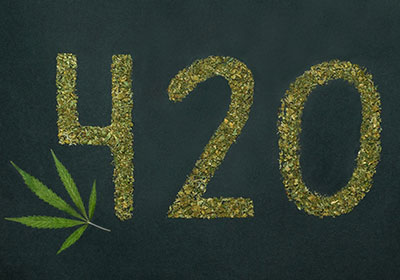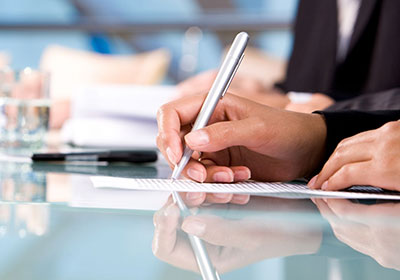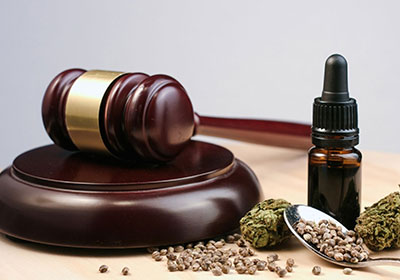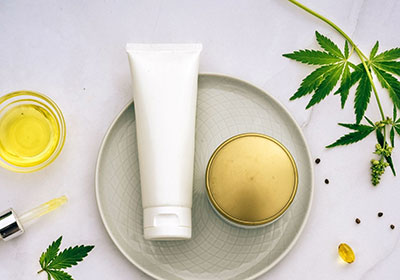It is no secret that pain management is the number one reason people utilize Medical Cannabis. And for the record, it’s generally chronic pain that patients are dealing with. Both THC and CBD are believed to help manage pain, even if they don’t eliminate it completely. But now it appears as though there might be another option: CBDA.
Known formally as cannabidiolic acid, CBDA is basically the precursor to CBD. We will explain what that means in just a minute. But first, animal research seems to suggest that CBDA could be a more effective pain reliever than either THC or CBD. In terms of the latter, CBDA could be many more times effective.
Seasoned Medical Cannabis users know that CBD is one of the two most commonly known cannabinoids found in the humble cannabis plant. CBD brings quite a few health benefits to bear without the side effect of getting high. But all CBD starts out as CBDA. Before you can have the former, you need to have the latter.
As an acid, CBDA has a carboxyl group. That carboxyl group has to be separated in order to turn CBDA into CBD. This process is known as decarboxylation, and the easiest way to accomplish it is to apply heat.
What holds true for CBD is also true for the rest of the cannabinoids. Until you remove the carboxyl group, cannabinoids do not offer the most desired benefits. And yet, all the cannabinoids in acid form may have a ton of benefits we simply don’t know about yet. That is where research into CBDA as a pain-fighting cannabinoid come in.
THC and CBD do what they do by binding to the CB1 and CB2 cannabinoid receptors. They can only do that because they have been decarboxylated. This implies that CBDA does not bind to those two receptors. Science has proven as much. Instead, CBDA seems to bind to more than half-a-dozen other receptors, particularly those related to the serotonin system.
Animal studies show a lot of promise for CBDA as a pain medication. But that’s not all. Early data indicates it might also be an immensely powerful drug for treating:
We will not know for sure how effective CBDA is without further human studies. But such is the case with nearly all of the cannabinoids and their precursor acids. Fifty years of prohibition has seen to that by limiting the amount of research that has gone into the cannabis plant.
If human studies eventually prove that CBDA does work as a pain treatment, it will give Medical Cannabis patients yet another choice. It would be a choice of better pain management without the side effect of feeling high.
At the current time, a limited amount of data we have on CBDA tells us that it is not psychoactive. Like its decarboxylated counterpart, CBDA will not make you high. But it could help reduce stress and anxiety while also offering some measure of pain relief. Let’s hope studies bear out the current assumptions.
In the meantime, you do have options. If you live in Utah and suffer from chronic or acute pain that hasn’t been successfully managed with other types of medication, don’t be afraid to ask your medical provider about Medical Cannabis. Getting your Medical Cannabis card would give you access to all sorts of products that could help you manage your pain better.
We talk a lot about Utah’s Medical Cannabis program and how it can be improved. Such discussions must be had. We have to make the Medical Cannabis program in this state as good as possible so as to maximize access and keep prices manageable. But that doesn’t mean we should be quick to complain. We are lucky that our list of qualifying conditions lets us treat pain with cannabis. There are other places in which the cannabis environment is a lot more restrictive.
Take the UK, for example. Medical Cannabis is technically legal there, but practical access is a different matter altogether. Patients with legitimate needs still have a challenging time getting their medications. That’s a shame. Why? Because there have been many success stories among the small number of UK patients who have actually been able to use Medical Cannabis
The Guardian recently ran a story about a Bristol woman diagnosed with both psoriatic arthritis and fibromyalgia some years ago. Both conditions can be debilitating by themselves. Combine them and you have a recipe for constant pain. That is exactly what this particular woman was experiencing.
According to the report, her pain was so severe that she rarely got more than two hours of continuous sleep. She was essentially nonfunctional to the point that she had to retire at just thirty-three years of age. For her, retiring at such an early age had implications far above the financial. She loved her job. She loved being out and about. But debilitating pain made that almost impossible.
Like so many other patients in her position, she tried one pill after another in hopes of managing her pain well enough to enjoy a normal life. Needless to say, she did not succeed. Then came the opportunity to participate in a Medical Cannabis study being conducted by a private London pain clinic. It changed her life – literally.
Once the woman began to treat her pain with cannabis, she noted that her pain levels have already dropped significantly. She is sleeping better than she has in a decade. Her number one task now is to gradually get off opioid pain pills. If nothing else, Medical Cannabis should be deemed a success if it helps people stop using opioids.
Without Medical Cannabis, this poor woman would still be struggling with unimaginable pain. Many of us will never know pain debilitating enough to completely separate us from normal life. However, those people who do experience such pain deserve relief. If that relief can be found in Medical Cannabis, society has no right to withhold it from chronic pain sufferers.
In the UK, accessing Medical Cannabis is still too difficult even though the drug is technically legal. Here’s hoping government officials figure out a way to make it more accessible. In the meantime, the program here in Utah is leaps and bounds ahead of the UK’s. We should be appreciative of how far our lawmakers have come since Proposition 2 was first passed.
It is easy to get angry and complain when things don’t go our way. It’s easy to recognize all the weaknesses in our current program and falsely assume that Medical Cannabis in Utah is one match short of a dumpster fire. But it’s not. We have a very good program that continues to get better with every legislative session. We have a program worthy of our appreciation.
If you suffer from chronic pain or any other qualifying condition that would be best treated with Medical Cannabis, we invite you to visit any of our Utah clinics for assistance with getting your Medical Cannabis card. Our team of experienced and compassionate QMPs are ready to lend a helping hand.
We are all pretty much into recycling, right? Well, maybe not all of us. But most of us do our part to recycle whenever we can. Here is something we have learned by picking the brains of experienced Medical Cannabis users: it is possible to recycle vaporized buds. In other words, you can use them a second time rather than throwing them away. It is not that hard, either.
Recycled buds previously used in a dry herb vaporizer are known in the cannabis community as already-vaped buds (AVBs) or already been vaped (ABV) buds. Whether you prefer to call it ABV or AVB, the material left over from a dry herb vaping session still has medicinal value.
You may remember that raw cannabis flower doesn’t offer much benefit in its natural state. The cannabinoids present in raw buds are still in acid form and are not yet active. You have to decarboxylate the plant material before it will help you. But as you know, the easiest and most effective way to decarboxylate is to heat the buds.
That’s the great thing about dry herb vaporizers. They both vaporize cannabis compounds and decarboxylate them at the same time. That means your AVBs are ready to go right out of your vaporizer. You don’t need to do anything more with them.
First, a word of caution. Cannabis that’s been used in a dry herb vaporizer has already released much of its THC and other cannabinoid content. But the leftover material can still be quite potent. As with any other cannabis product, remember to “start low and go slow.”
So, how would you give second life to AVBs? A lot of people do it by adding them to their food. For example, you can sprinkle AVBs on a piece of toast with peanut butter or mix it into some yogurt.
Just be careful that you don’t put it on food that others will consume. Your Medical Cannabis is just for you.
Another use of AVBs is making cannabis-infused butter or cooking oil. This butter or oil can then be used in virtually any recipe, such as brownies, that calls for it.
If this still isn’t enough for you, we have two more suggestions. The first is to steep the ABVs in hot water to make your own tea.
Yet another idea is to make your own tincture. If this sounds like fun, you can find plenty of recipes online. Making your own tincture could be one way to reduce your medical costs by extending the life of your buds. That way, you don’t have to buy as much on each visit to the Medical Cannabis Pharmacy.
We love the fact that Medical Cannabis patients are finding creative ways to extend the useful life of their medicines. working to recycle and reuse your already-vaped cannabis buds is just one way to get as much life out of vaporized plant material as possible. And it probably makes you feel better too.
Not only do you feel better physically, but you also feel better about yourself in the sense that you are taking more control over your healthcare. You are putting forth the effort to stretch your medicine as far as it will go.
We do not hear a whole lot about cannabigerol (CBG) these days. When it is talked about, discussions are usually limited to its potential as a medicine. But without a whole lot of evidence to prove what CBG can and cannot do, people are left to speculate. Does CBG have a place at the medical cannabis table? Maybe.
The thing about cannabis is that it isn’t just about THC and CBD. There is so much more to it. In fact, a lot of new Medical Cannabis patients who haven’t done a lot of research are surprised to learn that cannabis plants contain more than a hundred cannabinoids and terpenes. We just don’t know about the medical implications of each one right now. But that will come with time and research.
As for cannabigerol, it is sometimes called the “mother of all cannabinoids’ due to how it behaves in the plant itself. It turns out that CBG also behaves differently in the human body. It affects different receptors, thereby producing remarkably different effects as compared to THC and CBD.
According to The Cannigma contributor Matan Weil, some people refer to cannabigerol as the mother of all cannabinoids because they believe that its properties are responsible for determining the effects of other cannabinoids. However, science doesn’t back that up. He maintains that a better explanation for the term lies in the fact that CBG is a precursor to those other cannabinoids.
In other words, a cannabis plant produces CBG first. That cannabigerol is converted into other cannabinoid acids – like THCA and CBDA. By the time a typical cannabis plant is harvested, its actual CBG content is 1% or less.
Weil says that CBG is gradually becoming popular enough that growers are starting to produce plants designed to be CBG-heavy. In the same way they create varieties that are heavy on THC or CBD, they are starting to maximize cannabigerol volumes in other strains.
Research into CBG’s potential in medicine is still young, but it’s believed the cannabinoid could be useful in treating:
One thing we can say for sure about cannabigerol is that it is not intoxicating. Like CBD, CBG derived from industrial hemp can be bottled and sold anywhere in the U.S. And make no mistake about it, consumers are buying cannabigerol. Do a quick internet search and you will find all sorts of information from people who say it has helped them.
The more we learn about the cannabis plant, the more we understand Medical Cannabis efficacy. That is a good thing. The plant has had a cultural pall hanging over it for decades, and undeservedly so. We need to bring it back into the open and start medically researching it in earnest.
For more information about CBG, watch “The CBG Rundown” on the Discover Marijuana YouTube channel.
Do you know the difference between acute and chronic pain? Now that the Utah Legislature has added acute pain to the Medical Cannabis qualifying conditions list, you might qualify for a temporary Medical Cannabis Card at some point in the future.
There are restrictions to treating acute pain with Medical Cannabis. Still, expanding the list to include acute pain is a pretty big deal. We are thrilled the legislature has taken that step. With that in mind, let’s talk about acute and chronic pain.
For the purposes of defining chronic pain in state law, legislators decided that pain lasting more than two weeks was the starting point. That’s fine. There are other states that do not consider pain chronic until it lasts three weeks. Either way, chronic pain is pain that persists over an extended period of time.
It may be experienced every day. Then again, a patient may only feel pain every few days. The key is that it persists longer than two weeks. Now, here is where it gets tricky. The recent rule change also utilizes the two-week threshold as the starting point for qualifying acute pain.
The law specifically states that patients expecting to experience acute pain for more than two weeks may qualify for a temporary Medical Cannabis card. What makes acute pain different is its cause. It is not the result of a chronic illness. Rather, it is the result of a sudden event – like an injury or surgery.
It is interesting that the new rule specifically mentions surgery as a cause of qualifying acute pain. Even though surgeries are intended to ultimately help, they do cause injury by their very nature. Consider hip replacement surgery. In order to replace a hip, the surgeon has to damage existing tissue; there’s no way around it. Recovering from a major surgery like this can be quite painful.
From a treatment standpoint, acute pain is just as likely as chronic pain to be treated with opioids. It is no coincidence that the new law also references opioid treatment.
Patients who are expecting to experience post-surgery pain for more than two weeks may qualify for a temporary Medical Cannabis card if their pain would otherwise have been treated with opioids. In essence, changing the qualifying conditions list gives patients a second option. They don’t have to take opioid painkillers if they do not want to.
If you are considering Medical Cannabis for chronic pain or are expecting acute pain as a result of a future event, we encourage you to talk to your medical provider about your options. You might not have to settle for over-the-counter medications that don’t work well. You might not have to fill an opioid prescription just to get relief. Medical Cannabis could be your best pain management option.
Chronic and acute pain are defined differently for legal purposes. But in terms of management and treatment, they both qualify for Medical Cannabis in Utah under the right circumstances. We think this is good, and we expect a lot of Utah patients will agree.
Whether you refer to your medicine as Medical Cannabis or Medical Marijuana, what you purchase from a licensed Utah pharmacy starts out as a plant grown somewhere in the state. Growers can produce plants with feminized seeds, crossbreed to varieties of plants, or use cloning of existing plants. It is this third option that tends to confuse people.
We talk to people all the time who want to know what cloning is and whether it produces better Medical Cannabis. Fortunately, the answers to both questions are pretty straightforward. Despite all we don’t know about this amazing plant, we do know a lot about cloning and its effect on plant characteristics.
Start a discussion about cloning and most people will begin imagining some sort of futuristic, sci-fi environment in which human beings are being cloned from single cells. Images of Star Wars: The Clone Wars might even pop into your head. But cloning cannabis plants is not so extravagant or cutting-edge and the real world. It is not even a new practice.
Cloning a Medical Cannabis plant is a simple as cutting a piece off an existing plant and putting it into a specialized growing medium in hopes of it taking root. Farmers have been practicing it for millennia. Your mother or grandmother may have done it years ago in order to grow new plants at home so that they didn’t have to buy them from the nursery on the other side of town.
It turns out that some plants respond better to cloning than others. Cannabis is one of those plants that does very well. That is good for growers because controlling quality when you are growing plants from feminized seeds isn’t so easy.
Maximizing the benefits of medical cannabis is all about concentrating cannabinoids and terpenes. This is done through a combination of good growing practices and hybridization. But again, getting the exact results you want from seeds is challenging. So as soon as a grower manages to produce an exceptionally strong plant, that plant can be separated out and used as a mother plant for cloning.
In essence, cloning gives growers the opportunity to better control quality and consistency. It makes it easier for them to consistently produce high-quality plants season after season. And of course, that leads to the question of whether cloning produces better medicine.
The quality of any cannabis plant is affected by lots of things. That’s why Medical Cannabis is grown predominantly in controlled environments. Growers do not just plant a field and forget about it. Most of the cultivation in Utah takes place indoors, where growers can control everything from humidity to temperature to light exposure. They can also keep pests away.
All of this is to say that growers go to great lengths to ensure quality. Cloning helps inasmuch as it takes most of the characteristic variation out of the equation. Imagine you produce a THC-heavy plant with a particular terpene profile. Once you are satisfied with the quality of the plant, you can start cloning it. You can also control its growing environment by keeping your operation indoors. With few external influences to harm the plant’s quality, you can maintain its characteristics.
In a nutshell, cloned cannabis is a plant grown from the cutting of a mother plant. It tends to produce better quality Medical Cannabis simply because desired characteristics can be maintained with each clone. As Utah growers get better at cloning, the quality of the state’s Medical Cannabis continues to improve. That is good for growers and patients alike.
People tend to talk about Medical Cannabis in a very general sense. In other words, they discuss cannabis as though it is, in and of itself, a medicinal product. It is not. Cannabis is a plant. We extract certain compounds from the plant and use them as medicines. A critical step in the process is something known as decarboxylation.
Decarboxylation is that which makes cannabis effective as a medicine. If you attempt to use cannabis without decarboxylating it first, it isn’t going to do you much good. Why? Without getting too scientific, it is all about the natural state of the compounds in the plant.
The starting point for understanding decarboxylation is knowing that there is a lot going on inside a cannabis plant. A typical cannabis plant contains more than five hundred different chemicals. Just over 140 of them are cannabinoids. That’s what we’re after in terms of manufacturing Medical Cannabis products. We want cannabinoids like THC and CBD.
All the cannabinoids that naturally occur in plant material are actually in the form of acids. In that form, they do not interact with the human endocannabinoid system, which pretty much makes them of no medicinal value. We have to change their state to make them useful. That is what decarboxylation accomplishes.
Decarboxylation simultaneously separates an acid’s carboxyl group and releases carbon dioxide. You are left with an active cannabinoid that the human body can more readily interact with.
As far as how decarboxylation is accomplished, there are different ways to do it. The easiest and most common method is applying heat. For instance, a Medical Cannabis processor uses one of several methods to extract cannabinoids and terpenes from plant material. Extracts are then distilled in order to separate the individual components.
This is where it gets interesting. Distillation is accomplished by heating up the extract to boiling point. While the various components are being distilled the cannabinoids are also being decarboxylated. It’s a two-for-one that gives processors the cannabinoids they need to make Medical Cannabis products.
If you were to make your own edibles at home using raw flower, you would accomplish decarboxylation by heating the plant material. A lot of recipes call for breaking up plant material and adding it directly to the rest of the ingredients. Cooking those ingredients decarboxylates the cannabis. Plant material can then be strained away afterwards.
Just for the record, burning cannabis decarboxylate cannabinoids on the fly. That is why you can dry-heat unprocessed flower and still derive medical benefits from it. Dry heating doesn’t actually burn the material. Rather, it heats it to a temperature just below combustion.
Decarboxylation is frequently associated with turning inactive THCA into active THC. But the need to decarboxylate applies to all cannabinoids. So even if your medicines are primarily CBD products, a processor had to decarboxylate the CBDA to get useful CBD from it.
Now that you know the basics about decarboxylation, it should be easier for you to understand why Medical Cannabis processors in Utah are such a critical link in the chain. Utah law prohibits smoking marijuana, so patients need other delivery methods. All those other methods, with the exception of dry heating, require that cannabinoid acids be decarboxylated during processing.
Decarboxylation is the process that transforms cannabinoid acids into active cannabinoids. Although the cannabis plant has other uses, decarboxylation makes it an effective tool in treating medical conditions like pain and PTSD.

If you love the leaf, here are some ways to grow your knowledge and become a true cannabis champion.
For an article about smart ways to celebrate 4/20, this one might seem like a bit of a no-brainer. Nevertheless, we think the smartest way to use cannabis is with the protection of a Medical Cannabis Card.
As a Medical Cannabis cardholder, you can purchase, possess, and use cannabis without worrying about violating state laws. When you buy cannabis at a state-licensed pharmacy, you have the satisfaction of knowing your product is as safe and effective as possible.
Getting your card is easier than you might think. Visit utahmarijuana.org/reserve to schedule an appointment with one of our Qualified Medical Providers.
 Write Your Elected Officials
Write Your Elected OfficialsEarlier this month, the U.S House of Representatives voted in favor of the MORE Act, a bill to decriminalize cannabis at the federal level. None of Utah’s congressmen voted “yea” on the bill, but it’s encouraging that most members of the House want cannabis decriminalized.
A victory in the House alone isn’t enough to decriminalize cannabis. For the measure to become law, the U.S. Senate also has to grant its approval. Although the MORE Act is not expected to advance through the Senate, some senators are working on their own solution.
U.S. Senator Chuck Schumer and some of his colleagues are working to finalize provisions in the Cannabis Administration & Opportunity Act (CAOA). Like the MORE Act, CAOA would repeal the federal prohibition of cannabis by removing it from the US Controlled Substances Act.
If you want the federal prohibition of cannabis to end, consider writing to the congressman and senators elected to serve you. You can do this very easily on the Marijuana Policy Project website. For even further impact, look up your representatives in the Utah Legislature and write to them too.
 Do Your Part to Destigmatize
Do Your Part to DestigmatizeFor the last several decades, people raised in America have been exposed to a barrage of powerful anti-cannabis messages. In recent years, a majority of states have legalized cannabis in some form, but there remains a heavy stigma around the drug.
Despite polls that show a majority of American voters support legalization, some people still view cannabis as part of a counterculture.
Many of them will never change their minds about cannabis. Others will change their minds, but only if they hear about the benefits of cannabis from someone they trust. Someone like you.
Destigmatizing cannabis certainly won’t happen overnight, but we might accelerate the process by sharing our viewpoints with others. If Medical Cannabis has helped you in some way, consider sharing that information with people you know.
The story of your unique experience with cannabis might be all it takes to help someone else understand its value as a powerful and effective medicine.
 Donate to Uplift
Donate to UpliftUtah now has nearly 50,000 patients registered in its Medical Cannabis program. We’re encouraged that such a large part of the population can finally get the relief they need.
But there are other qualifying patients who, for financial reasons, have yet to join. That’s why we decided to launch Uplift, a charity that subsidizes Medical Cannabis evaluations for those in need.
Since December, our patients and partners have helped us raise enough money to fund Medical Cannabis evaluations for over 100 people. Through donation-matching, Utah Therapeutic Health Center and its partners multiply donations by 800%.
If you enjoy the privilege of using Medical Cannabis, consider helping others to do the same. Visit utahmarijuana.org/uplift for details.
 Know Your Rights
Know Your RightsAs we said earlier, Medical Cannabis cardholders in Utah can legally purchase, possess, and use cannabis. But there are some limitations to those privileges.
WholesomeCo Cannabis lawyer JD Lauritzen and UTTHC founder Tim Pickett answered the most common questions about Utah’s Medical Cannabis laws. Click here to watch their “Know Your Rights” webinar on YouTube.
On 4/20, remember that using cannabis in public view is still illegal, even for Medical Cannabis cardholders, except in emergencies. We recommend using your cannabis at home, or at another private residence whose owner has given you the green light.
 Try Something New
Try Something NewIf you’ve been using Medical Cannabis for a while, you’ve probably figured out your “go-to” strains and methods of consumption.
You might prefer to inhale cannabis using a cartridge or a dry herb vaporizer. Maybe you prefer using cannabis in an edible or a tincture form. But there are other ways to use Medical Cannabis that you may not have heard of or tried yet.
Medical Cannabis is available in a variety of delivery methods, and you might not be using the best one for your needs. Next time you’re at the pharmacy, consider picking up a product that is entirely new to you.
If you need fresh ideas, we’ve put together a handy shopping guide with a variety of suggestions on Medical Cannabis products to try.
From everyone at Utah Therapeutic Health Center, we wish you a safe and happy 4/20!
Utah’s Limited Medical Provider (LMP) program was launched in earnest recently. The program is meant to expand access to Medical Cannabis by allowing more types of healthcare providers to write recommendations for the drug. But, when possible, we urge LMPs to advise patients to visit a Qualified Medical Provider (QMP) to obtain a Medical Cannabis Card.
The Medical Cannabis Card represents a patient’s opportunity to access medicines that can only be obtained by way of a Medical Cannabis pharmacy. The card also represents a medical provider’s recommendation that cannabis be utilized as a treatment. We believe that the QMP is the most qualified medical provider to offer that recommendation.
Prior to launching the LMP program, Utah’s Medical Cannabis patients could only obtain their cards after visiting with a QMP. Now they can visit with either a QMP or LMP. What is the difference?
A QMP is a medical provider licensed by the state of Utah with prescribing authority and state certification to recommend Medical Cannabis to up to 275 patients. If a QMP is “certified by the appropriate American medical board”, in certain areas of specialty, up to six hundred recommendations can be made.
An LMP is also a state-licensed medical provider with prescribing authority in Utah. The LMP can be a physician, nurse practitioner, physician assistant, or podiatrist. LMPs can recommend Medical Cannabis to up to 15 adult patients (ages 21 and up) at any one time.
The big difference between the two types of providers is training. Unlike QMPs, LMPs are not required to receive any additional training in the human endocannabinoid system or cannabis as a medicine. In order to become a QMP, a medical provider must complete an approved training course.
Although LMPs aren’t required to undergo additional Medical Cannabis training, the state does provide some training resources for them. See the “Limited Medical Provider Resources” section on this page for details.
To us, the main difference between the LMP and the QMP is education. In addition to the state-mandated training program, QMPs often have more education in Medical Marijuana and its use as a medicine. They tend to be more educated in how Medical Cannabis can be used as an effective treatment for conditions like chronic pain, PTSD, seizure disorders, etc.
This really is the main reason we urge LMPs to advise their patients to see a QMP to obtain a Medical Cannabis card. There is still a lot that medical science does not know about cannabis as a medicine. As such, standard medical training doesn’t necessarily equip a medical provider to truly understand the benefits of using cannabis as a medicine.
In the best interests of patients, their medical providers should have a good understanding of Medical Cannabis. They should be up to date on the latest research. They should understand things like Medical Cannabis delivery methods and dosage. Medical providers should have a basic grasp of things like layering and the differences between CBD and THC.
The state legislature did the right thing by approving the LMP program. The program us especially important in rural parts of the state, where patients may not have reasonable access to a QMP. In such cases, being able to visit with an LMP to obtain a Medical Cannabis Card is a better option than continuing to go without what could prove to be a life-changing medicine.
Having said that, we do think it is best for patients to visit with a QMP when possible and practical. A QMP has gone beyond standard medical training to learn about Medical Cannabis and its applications. In that sense, it would be fair to think of recommending Medical Cannabis as somewhat of a specialty. QMPs are the specialists in this case.